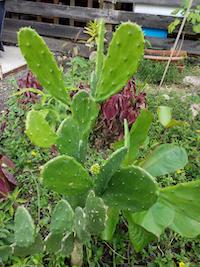Tropical Garden Grow Guide
Where you are the student and the teacher
Prickly Pear - May 2022

| Botanic Name |
Opuntia Humifusa |
| Sun Expoaure |
Full Sun |
| Plant Type |
Herbaceaus, Perennial, Cactus |
| Family |
Cactaceae |
| Plant from |
Seeds or Cuttings |
| soil type |
Well Drained |
| Height |
to 18 ft |
| Soil pH |
6-7 |
by Karin Westdyk
Prickly Pear has 3 edible sections: the pad or paddle of the cactus (called nopal), can be used as a vegetable; the flower petals can be used as a garnish or added to salads and; the pear, which can be eaten or used like any other fruit.
Growing prickly pear from seed is a very
slow process and can take up to a few years for fruits
and flowers to set. Propagation from cutting a pad is
far simpler by twisting it off, letting dry for about a
week and placing it upright in the soil about 1 inch
deep. Within a week or two it will form a basis for its
root. Then water about once a week.
Originating in Mexico where it is called Nopal, prickly pear has significant nutritional and medicinal properties. It is rich in magnesium and taurine, substances important for brain and heart health and contains lots of vitamin C. The plant also contains flavonoids like quercetin, and isorhamnetin and kempferoli.
Other components are carbohydrates
(glucose, fructose and starch), protein and fibers rich
in pectin. It is rich in antioxidants with
anticancer properties and is considered a protector of
the eyes and joints. It is also used to relieve pain.
Choose the young
tenderest pads to eat raw or cooked and use in soups,
stews, salads, breads, desserts, beverages, and
marmalades. They can also be used as fodder for
animals. The fruit, called in some cultures, the tuna,
is also edible and the bright flowers are an important
source of food for bees and other pollinators.
Recipes:
The prickly pear pads can be used
in a variety of nutritious dishes such as salads,
stews, omelets, casseroles and tortillas. They can
also be pickled and used as a condiment.
Prickly Pear with eggs (Nopalitos con
Huevos)
from
https://www.onionringsandthings.com/nopalitos-con-huevos/#respond
Ingredients
2 pads
(nopales)
2 cloves garlic,
peeled
salt to taste
1 tablespoon vegetable
oil
1/2 small
onion, peeled and chopped
4 eggs,
beaten
pepper to taste
cilantro,
chopped
corn or flour
tortillas
Instructions
Using a small paring knife, clean the
cactus pads by scraping thorns or spines from both
sides. Trim off the edges and any blemished or
discolored areas. Wash well with cold water.
Cut the pad lengthwise into half-inch
thick strips and then cut crosswise into 1 to 1
1/2-inch lengths.
In a saucepan over medium heat,
combine garlic, salt, and enough water to cover the
pads. Bring to a boil.
Add pads and cook for about 20 to 25
minutes or until they have changed color and are
tender yet crisp.
Drain pads and rinse well under very
cold water. Rinse again as needed to rid of mucilage.
In a skillet over medium heat, heat
oil. Add onions and cook until softened.
Add pads and cook for about 2 to 3
minutes.
Add eggs and cook, stirring
regularly, until eggs are set but still slightly
wet. Season with salt and pepper to taste
Remove from heat, garnish with
chopped cilantro and serve with warm tortillas.
Prickly Pear Fruit Syrup
INGREDIENTS
1
½ cups prickly pear
3 cups water
½ cup sugar
INSTRUCTIONS
1.Take your
de-thorned prickly pears and cut them in half.
2. Scoop out
the middle fruit and add to a pot with the water and
sugar.
3. Bring to a
gentle boil, then reduce the heat to simmer.
4. Allow the
mixture to simmer, stirring occasionally, for 30
minutes. When the mixture thickens, remove from the
heat and allow to cool.
5.Take a
soup ladle and add one scoop of the mixture to a
strainer. (Make sure the strainer is over a bowl.)
6. Use a
spoon to press the prickly pear mixture into the
strainer to get all of the liquid out. Empty the
strainer of the seeds and thick pulp and repeat until
you do this with all of the prickly pear mixture.
7.
Chill for one hour.
Prickly Pear Fries
Ingredients
1. 3-4 fresh cactus
(Nopales) paddles
2. 3 tablespoons
cornstarch
3. 2⁄3 cup all-purpose
flour
4. 1/3 cup bread crumbs
5. 1/2 tsp powdered
chipotle
6. 1 teaspoon baking
powder
7. 2 egg whites
8. 3⁄4 cup ice water
9. Vegetable
or peanut oil for frying
Instructions
- Rince and thoroughly remove thorns
and “eyes” from cactus, and trim off the edges of
pads.
- Blanch paddles for 2 minutes in a
covered pan with enough boiling salted water to
cover; drain and allow to cool until comfortable
enough to handle.
- Cut cactus into thin strips similar
to French fries, and set aside.
- Beat egg whites until stiff, then
set aside
- Combine dry ingredients well.
- Fold beaten egg whites into the
flour mixture, alternating with enough ice water to
make batter the consistency of unbeaten egg white.
Place in the refrigerator to chill at least 10
minutes.
- Dredge cactus strips in batter, and
fry in deep hot oil until crisp and golden.
- Drain well, serve and enjoy!